Palo Alto, Mexico – an Inspiring Story, a Mission to Preserve
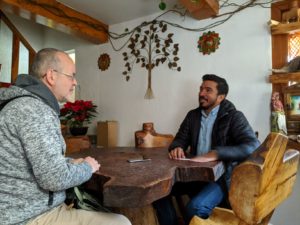
This report was written by Richard Audet, a communications consultant living in Montreal, Canada. The original article appeared in CITÉCOOP, FECHIMM’s (the Montreal area cooperative housing federation) quarterly magazine.
On the site of a former sand mine, about ten kilometres from the centre of Mexico City is the Palo Alto Housing Cooperative. It is not just a single building, but an entire working-class neighbourhood, incorporated as a cooperative. About 2,500 people live in the many small, colourful houses and the few buildings that line the streets.
“Palo Alto is an emblematic case of the struggle for the right to the city,” said Enrique Ortiz, the architect who led the design of the community. It’s a right for everyone, not just those who can pay, the New York Times reported in an article on the cooperative, published in 2017.
The story of Palo Alto is one of poor families from rural Mexico in the 1930s looking for work. Families, who after living and working in miserable conditions, were able to take possession of the land in 1973, four years after the end of mining. They had to fight a long and difficult battle to win their bet. The support of a neighbouring religious community, including two priests strongly imbued with liberation theology, was decisive.
Today, Palo Alto is a peaceful place to live, but the neighbourhood is wedged between highways, luxury shopping malls and skyscrapers that grow all around. A sign of the gentrification in this affluent sector of the megalopolis: land prices are reaching record highs. The classic scenario, coupled with a decline in collective values, puts strong pressure on the co-operative. Some members looking for financial gain would like to obtain the right to sell their shares. The coop does not intend to let them do so. The battle to preserve Palo Alto is ongoing. It requires better training and a reminder of cooperative values, think its defenders.
Richard Audet visited this very special coop in December 2019 and Luis Márquez, in charge of the coop’s external relations, was his guide. Through the eyes of this child from Palo Alto, a lawyer and activist resolutely committed to land and housing rights, we invite you to discover this unique neighbourhood of Mexico City.
The History of Palo Alto
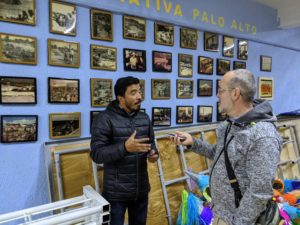 In the 1930s, families from rural Mexico converged on the capital to find work. The owner of the Santa Fe mines recruited them, assigned them a place to live and charged them rent, which he deducted from their wages. “We had to build our houses out of dirt, cardboard and whatever else we had on hand. If we didn’t have money, we made the roofs with grass. If we had money, we would buy cardboard,” says Telesfora Rivera, a dean of the coop. Living conditions are very difficult. The workers barely earn enough to feed their families. Sometimes they are paid with corn and beans. They live in huts or caves without access to running water, septic systems or electricity. Families learned that they would be evicted from the site when the deposit was depleted in the late 1960s. That’s when the coop housing project began.
In the 1930s, families from rural Mexico converged on the capital to find work. The owner of the Santa Fe mines recruited them, assigned them a place to live and charged them rent, which he deducted from their wages. “We had to build our houses out of dirt, cardboard and whatever else we had on hand. If we didn’t have money, we made the roofs with grass. If we had money, we would buy cardboard,” says Telesfora Rivera, a dean of the coop. Living conditions are very difficult. The workers barely earn enough to feed their families. Sometimes they are paid with corn and beans. They live in huts or caves without access to running water, septic systems or electricity. Families learned that they would be evicted from the site when the deposit was depleted in the late 1960s. That’s when the coop housing project began.
Nearby is a school run by a religious community. Children of the workers are admitted. In this private institution, supported by wealthy families in the area, one becomes aware of the poor living conditions of these children, who are malnourished and in poor health. Church leaders encourage families to mobilize for change. Two priests who are supporters of liberation theology will be the driving force behind the collective awakening that will enable the cooperative to see the light of day.
Teacher Carlos de Anta succeeds in getting the school’s parents’ association to support the neighbours of Palo Alto by integrating a team of professionals to design the cooperative’s project, buy the land and improve the quality of life of the population. Another priest, Rodolfo Escamilla, who is associated with several social causes in Mexico, carries out training, awareness-raising and political organizing activities. “He taught us to fight for a dignified life,” he writes about the coop on his Facebook page.
The Palo Alto project was born in 1973, after a very long legal battle. The coop then obtained the site at a symbolic price. Construction can begin. Several phases of development will follow one another. Rodolfo Escamilla was assassinated in 1977. His killers were never found. Every year since then, the residents of Palo Alto celebrate the birthday of this man who helped them unite in the struggle for dignity.
Cooperative Operations
In many ways, the operation of the housing coop – a concept not very common in Mexico – is similar to that of coops in Montreal. The collective priority system gives residents the right to housing and excludes all forms of speculation. The coop is governed by a board of directors and a general assembly. Committees are also formed. Gender equality is the subject of one of these committees.
The cooperative is a form of local government, but it is not legally recognized. It operates in a legal vacuum. The cooperative avoids tax increases linked to the gentrification of the sector. The calculation of its property assessment takes into account its popular character and results in a lower level of taxation.
Palo Alto has no employees. All work is done voluntarily by residents. Participation issues exist, but the coop always finds people to do the work.
Membership is reserved for the founders and their estate upon their death. There are 245 members out of the approximately 2500 residents. Membership is most often passed from men to their wives and then to their children. Non-member beneficiaries must be involved in the management of the cooperative and in the maintenance of common areas. They are also responsible for the maintenance of their house or dwelling.
Training and adherence to cooperative values is a challenge. There is a generation gap, as cooperative training has not been maintained. We need to instill these notions in young people. “Although many were born here, there is no guarantee that they will have the cooperative spirit,” says Luis.
The Effects of Gentrification
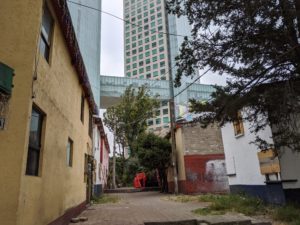 Gentrification puts constant pressure on the cooperative. “What they [developers] are trying to tell us is that we don’t belong here,” says Luis. “Unsurprisingly, gentrification is having the same effect here as it is anywhere else in the world. It’s pushing the less well-off further and further away from the centre. In Mexico City, many people have to drive two hours to work and two hours back. That’s why they want to deport us and send us to remote areas,” he says.
Gentrification puts constant pressure on the cooperative. “What they [developers] are trying to tell us is that we don’t belong here,” says Luis. “Unsurprisingly, gentrification is having the same effect here as it is anywhere else in the world. It’s pushing the less well-off further and further away from the centre. In Mexico City, many people have to drive two hours to work and two hours back. That’s why they want to deport us and send us to remote areas,” he says.
This is not a new phenomenon. More than 20 years ago, about 40 coop members, the dissenters, as they are called, took their case to court to get the right to sell their homes. A court decision in 2015 guaranteed the coop’s residents the right to their homes. However, it forced the coop to buy back the dissenters’ shares. Pending the buyback, which is estimated to cost more than US$1 million, the dissenters’ homes are unoccupied and many are in poor condition. The idea of selling is also still present among the members. “There are people who want to sell because we are in an area of Mexico where one square metre can cost up to US$7000. They think that if they sell, they can make a lot of money. So they want the assembly to decide that the houses can sell,” Luis explains. So our role is to remind people of the cooperative principles and values, the history of the coop, our roots, the quality of life we have and the fact that the role of the coop is to secure housing,” he continues.
Infrastructure and expansion projects
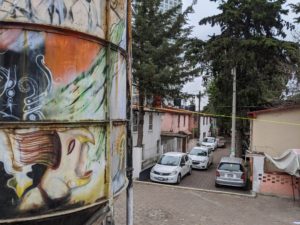 Infrastructure development within the community has also been the subject of major battles over the years. The community and cultural centre, the soccer field and the children’s playground are among the achievements.
Infrastructure development within the community has also been the subject of major battles over the years. The community and cultural centre, the soccer field and the children’s playground are among the achievements.
Increasing services is now at the heart of the project. These include social services and a clinic. The addition of a second floor to the community centre is also planned. “We would like to create a commercial space where women can sell their products. The project of a school in the neighbourhood is also part of the plans. Our dream is to turn it into a cooperative school that trains children, youth and adults in the principles and values of the movement,” says Luis.
Neither the federal state nor Mexico City has a specific program to fund housing coops. Programs aimed at community improvements and citizen participation have been used in recent years to fund projects.
A Safe Neighbourhood
“Despite the appalling statistics on crime and femicide in Mexico, Palo Alto is a very safe place to live, no matter what time of day or night,” says Luis. “We never lock the door of the house. Our children leave their things outside and no one steals them. Security comes from the fact that we know each other. We protect each other,” states Luis.
Women’s Contribution
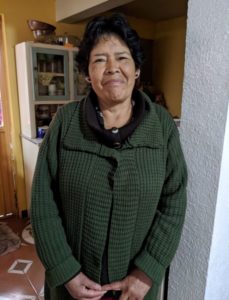 It was the women who led the legal battle and obtained all the necessary permits. It was women who forged Palo Alto, but machismo and the patriarchal system meant that 80% of the members were men,” laments Luis.
It was the women who led the legal battle and obtained all the necessary permits. It was women who forged Palo Alto, but machismo and the patriarchal system meant that 80% of the members were men,” laments Luis.
The cooperative model empowers women and that is part of the Palo Alto project. Over time, the men started to die. The members are now mostly women. In the new generations, there are also more women members,” he continues.
In Palo Alto, women also participate in the economic life of the neighbourhood. They create jobs for the local population. For example, they run small restaurants where employees from the surrounding offices come to pick up the day. These are very affordable restaurants for ordinary people like us who can’t afford an expensive meal,” says Luis.
Quotes from Palo Alto Residents
Telesfora Rivera: At the time, I worked in rich people’s houses, but then I came back to my hut. We lived without water. There was a public tap. Sometimes there was water. There was also a tunnel where we went to get water for washing. It was difficult to live here. When I entered this house, for me it was a palace. Now I am happy because I have everything, I have water.
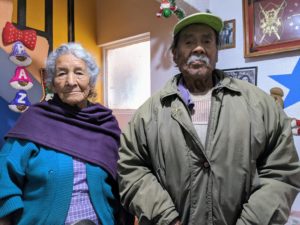
Josefina Juárez Guerrero and Pablo Escobar: When I came here, I was nine months old. I started working in the mines when I was 12 years old. We used dynamite and dug in the sand with our pickaxe and pickaxe. There was also copper and silver. We lived upstairs where the road is, we had little houses made of cardboard, earth and grass. (P.E). At the time of the popular mobilization for the cooperative project, I couldn’t make much effort because I was pregnant with my daughter, the others worked hard. (J.J.G).
Elena Escobar Juárez: We’ve lived here forever and we’re happy. Now it’s our turn to fight for continuity and to defend the land. This has cost our parents a lot of money. We work and we take part in committees. I got involved in the social prevention group. Women, rain or shine, we’re here!
Luis Escobar Juárez: Thanks to the coop, I have a decent house. If we weren’t in the coop, we wouldn’t be here. This is a very privileged area. There’s a strong demand in the real estate market in this area.
Este artículo también está disponible en francés y en español.
Cet article est également disponible en français et en espagnol.

